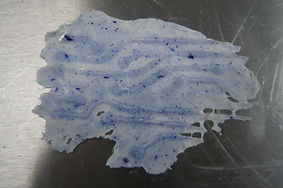Makeup Exploration










Natural Gelatine
Blue Pigment
UV Blue pigment
Conclusion
The colour mixed much better than the blue arcylic paint, most likely due to it being less pigmented. However is still left colour inbetween the veins and therefore their shape was not defined. The UV paint worker well under the Lamp but again the lines were less defined as their was gelatine inbetween.
I have found that Gelatine is not a suitable material to use for flat pieces as it is very difficult to move it once its on the mould. Therefore it produces an uneven and less precise piece and does replicate the orginal sculpt. However I have discovered that acrylic paint does not mix evenly with gelatine, but it does produce an interesting texture and pigmentation that could be used within my future work. Also It became very obvious that gelatine is a much quicker, less expesive material to use when casting, and perhaps can allow me to visual a piece to see if correct without the cost of using silicone each time. Also when mixed with UV paint, it glows well under a UV lamp, this could be usefull when creating future makeups.
As before, i wanted to experiment with different pigments. I discovered that blue acrylic paint does not mix well with gelatine, but it just breaks up and goes patchy. Again because it does not spread well within the mould, the lines were not defined and the gelatine covered the whole area. However I really like the texture and colour produced within the gelatine, and although it is not suitable for the circuit veins, i will consider this method in the future.
I then painted over the top with a blue alcohol activated paint, which sunk into some areas more than others, which added depth to the veins. The gelatine made them look very translucent on the skin, but they did not appear to look as intergrated into the body as the silicone pieces.
I wanted to see the effects that may be produced from a different material than silicone. I chose to use Gelatine, which is a cheaper and quicker material to use when casting.
I heated up the gelatine in the microwave and quickly applied it the mould. I found this difficult as it set very quickly due to the temperature of the silicone flat piece, which meant that i was not able to scrape across to make it even as it just stuck to the taping knife.
This left the piece thicker or holes in areas.
I applied the piece, using pros-aide, which was much quicker and simpler than the silicone piece. The edges dissolved well using witch hazel and blended into the skin smoothly.
However the lines were uneven due to the gelatine not spreading well into the mould.
